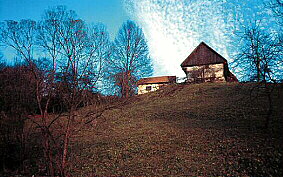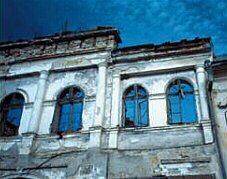 |
| Much of the Apuseni Mountains still remains relatively pristine |
A site in Romania’s Apuseni Mountains is currently being prepared
for production of gold due to start in 2005. Over the gold mine’s estimated
17-year life span, 23 tonnes of gold and 81 tonnes of silver will be extracted
annually using cyanide technology. The project is run by Rosia Montana Gold
Corporation, a joint venture between the private Canadian company Gabriel
Resources Ltd. (80%), the Romanian state-owned Minvest SA Deva (19, 3%),
and small shareholders (0,7%).
This mining activity requires an investment in excess of USD 400 million.
In a recent move, the World Bank refused to participate in the USD250m loan
for the controversial project. The International Finance Corporation (IFC),
the bank’s private-sector lending arm, announced in October 2002 that
it was abandoning negotiations with the Canadian company Gabriel Resources
Ltd. over a loan that was to back the mining project. The bank’s involvement
wouldn’t have exceeded USD100m. The decision was taken during the World
Bank’s annual meeting in response to heavy criticism from activists
that the bank was backing environmentally dubious projects, such as Rosia
Montana. During the meeting, representatives of an international coalition
against the project had spoken to the bank’s president, James Wolfensohn.
The international coalition includes Alburnus Maior (from Rosia Montana,
Romania), CEE Bankwatch Network, Friends of the Earth International, Greenpeace
CEE, Mineral Policy Center (Washington DC, USA), and Mining Watch Canada.
 |
| Decades of neglect have ruined cultural vestiges |
The IFC was still studying the project’s possible environmental impact
when it "has taken the decision not to move forward with the Rosia
Montana project”. The IFC’s statement is based "on the indications
from the sponsor that there is available commercial funding for the project”,
and also on "our concern that IFC’s involvement may require the
company to proceed with the project more slowly than they wish”.
The NGO coalition that opposes the project welcomed the IFC’s statement.
Eugen David, president of Alburnus Maior, the local community group, said:
"For well over two years we have been confronted on a daily basis with
a psychological war to make way for the project. Today marks an important
victory in our struggle to keep our land for our children. We are overjoyed
and congratulate the IFC for its decision. We hope that other financial
institutions and banks will follow suit and pull out or refrain from investing
in this speculative, unprofitable and unsustainable project that will only
increase pollution, poverty, and corruption.” However, Robin Hickson,
Gabriel’s president, confirmed that the company fully intends to proceed
without IFC support. The company approached the IFC, he said, primarily
to gain environmental and social assistance, and less for financial help.
According to the international NGO coalition, "Gabriel Resources’s
plan, in order to be economically feasible, would transform the valley of
Rosia Montana, the oldest documented settlement in Romania, into four open-pit
mines. The neighbouring valley of Corna would be converted into an unlined
cyanide storage ‘pond’ covering a surface of up to 600 hectares,
held back by a 180-meter high dam. The pits would generate roughly 196.4
million tonnes of cyanide-laced waste.”
The project would also relocate more than 2,000 people and destroy around
900 houses where the mine is planned. According to the environmental coalition,
several of the local inhabitants do not wish to leave their lands. However,
in March 2002 "the mining company started an aggressive relocation
programme, in the absence of adequate public hearings or any Environmental
Impact Assessment”.
Once commercial operations have started, the mine would employ a workforce
of approximately 500 people. Toronto-based Gabriel Resources Ltd. is registered
in Barbados. According to the NGO coalition, "the company has no previous
mining experience”. It’s "founder and chairman Frank Timis
has two convictions for possessing heroin with the intend to sell. An earlier
venture of Mr Timis, a Ukrainian petrol company, had been barred from the
Toronto stock exchange. Gabriel Resources is currently listed on the Toronto
exchange.”
 |
| Anne Burrill, principal administrator for the collaboration with European third countries at the DG Environment, European Commission |
Two years ago, an accidental cyanide and heavy metals spill at another
Romanian gold mine, Aurul Baia Mare, affected almost 2,000 kilometers of
rivers in the Danube river basin, contaminating the drinking water supplies
of 2.5 million people, and killing some 1,200 tonnes of fish.
Remembering the Baia Mare accident, Frits Schlingemann, UNEP Regional Representative
for Europe, warns against risks coming from new mining projects that relay
on the use of cyanides. "At this stage of development, a country like
Romania, which has serious problems with floods and other natural disasters,
is not yet prepared to cope with the risks of another cyanide spill-over”,
says Schlingemann, who was the head of the UN Commission for Baia Mare.
He adds: "I am sorry to say that none of the two proposals made in
the wake of the Baia Mare accidents were yet taken seriously by the Romanian
Government”.
The first proposal was a river management plan and possibly an international
convention for the Tisa River Basin, including the interests of the downstream
countries, and a potential financial contribution of Hungary to prevent
future accidents. The second involved more the local population. "A
lot of damage could be prevented if the downstream population was better
informed”, said the Dutch.
Of course, decisions regarding potentially hazardous investments, such as
the USD 400-450-million Canadian-Romanian open-pit gold mine in Rosia Montana
are rather complex, "one of the clear issues being the split between
employment needs and environmental hazards”.
Recognising the complexity of the issue, and hoping to find directions to
follow, Romanian environmental authorities turned their heads towards the
European Commission. But Anne Burrill, principal administrator for the collaboration
with European third countries at the Environment Directorate-General, says
that any decision regarding the project will have to be taken at the national
level. According to Burrill, there are three reasons for that: 1) Romania
is not a EU member, 2) there are no EU funds involved in the project, and
3) the EU has no specific legislation regarding cyanide gold mining. However,
there is a European proposal for an amendment to the Seveso 2 Directive,
which would cover certain aspects of mining wastes, adds Burrill. The EC
also envisages the launching of an additional broader mining waste initiative.
In time, Romania will adopt the whole acquis communautaire, as any other
candidate state. Nevertheless, warns Margot Wallstrom, Environment Commissioner,
"a legal act is as good as its implementation”.
Burrill went on to say that "in all our discussions with the Romanian
Government representatives, the European Commission has stressed the importance
of ensuring that the principles of the Environmental Impact Assessment Directive
are respected in all new investments, including the case of Rosia Montana,
and that decisions are taken with due respect for transparency, and proper
consultation".
According to Petru Lificiu, the Romanian Minister of Waters and Environmental
Protection, the final decision regarding the authorisation of the Rosia
Montana project has been passed on to the Parliament, due to the national
importance of the case.